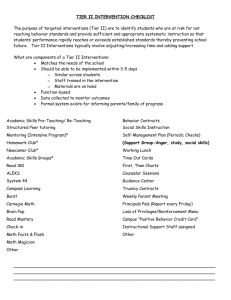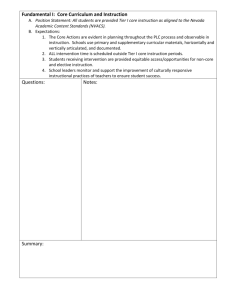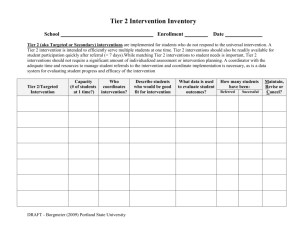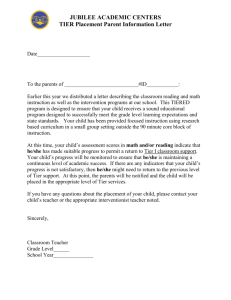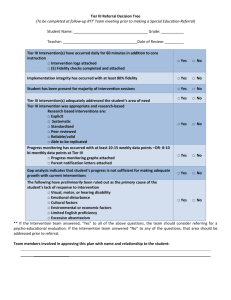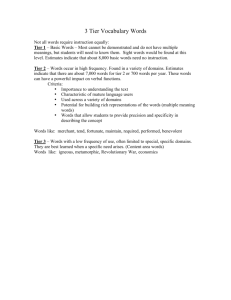Understanding Response to Intervention
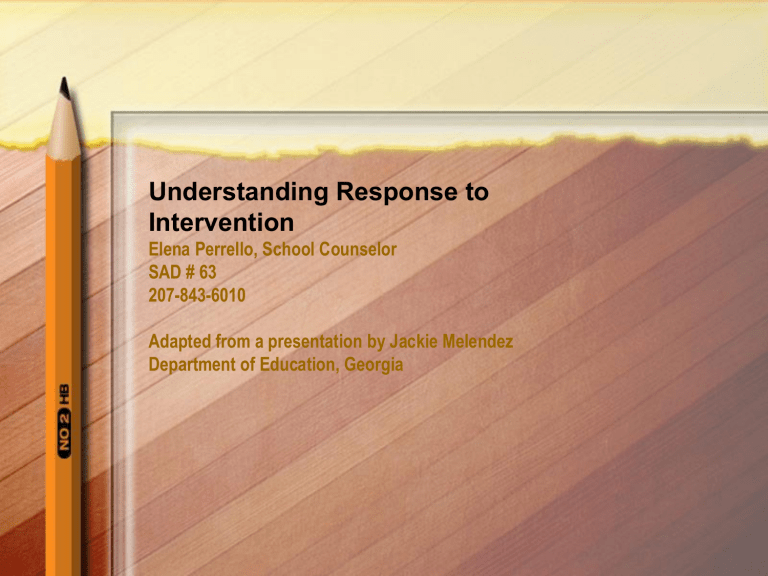
Understanding Response to
Intervention
Elena Perrello, School Counselor
SAD # 63
207-843-6010
Adapted from a presentation by Jackie Melendez
Department of Education, Georgia
Student Achievement
Pyramid of Intervention
Tiers of support for students who are struggling with:
– Academics
– Communication/language deficits
– Appropriate school behavior/social skills
2
Provides assistance to any student
Pyramid of Interventions
Represents the process of continually implementing progress monitoring.
Provides layers of more intensive interventions so that students can be successful.
Reduces the number of students requiring placement in special education.
Our Goal :
Building a Student Achievement
Pyramid of Intervention
that includes both
PREVENTION & INTERVENTION STRATEGIES
To assist in improving the achievement of ALL students
STUDENT ACHIEVEMENT PYRAMID OF INTERVENTION
Increasing
Intensity of
Intervention
TIER 4
SPECIALLY DESIGNED
LEARNING
Targeted students participate in learning that includes:
• Specialized programs
• Adapted content, methodology, or instructional delivery
• Access/extension
TIER 3
SAT DRIVEN LEARNING
Targeted students participate in learning that is in addition to Tier 1 and Tier 2 and different by including:
• Individualized assessments
• Interventions tailored to individual needs
• Referral for specially designed instruction if needed
Decreasing numbers of students
TIER 2
NEEDS BASED LEARNING:
Targeted students participate in learning that is in addition to
Tier 1 and different by including:
• Formalized, systemic processes of intervention
• Greater frequency of progress monitoring
TIER 1
STANDARDS-BASED CLASSROOM LEARNING:
All students participate in general education learning that includes:
• Implementation of the Maine’s Performance Standards through research-based practices
• Use of flexible groups for differentiation of instruction
• Frequent progress monitoring
Georgia Department of Education Kathy Cox, State Superintendent of Schools April 12, 2006 All Rights Reserved
RTI Pyramid
5%
15%
Tier 3:
Intensive, Individual
Interventions
Individual Students
Tier 2:
Targeted Group
Interventions
Some (at-risk) Students
Tier 1:
Core Instructional
Interventions
All Students
80% of Students
RTI/Response To
Intervention
A process of implementing high quality, scientifically validated instructional practices.
Based on learner needs.
Monitors student progress.
Instruction based on student’s response.
Core Principles
All children can be taught.
Early Interventions.
A multi-tier, integrated model of service delivery.
Uses a problem solving method.
Must be researched based and scientifically validated.
RTI Fidelity:
Is the intensity and accuracy with which instruction and intervention is implemented.
RTI- WHY?
Re-Authorization of IDEA 2004.
In part says that a school will “use a process which determines if a child responds to a scientific, research based intervention as part of its evaluation procedure”
Tier 1- Core Instructional
Interventions:
Involve ALL students.
Use a standards-based curriculum.
Use research based strategies.
Include differentiated instruction.
Have effective classroom management strategies.
Tier 1 Assessment
Frequent
Balanced
Curriculum based
Monitor progress over time
Tier 2 Targeted Small
Groups & Selected
Individuals
Standard treatment protocols
Researched- based strategies.
Tier 2 Assessments
Progress Monitoring for
* Academic
*Behavior/Social and
*Learning Processes
Tier 3- Selected Individuals
Strategies and interventions are tailored for the specific needs of the individual student.
Tier 3- Assessments
More in- depth assessment and analysis of the concerns and needs of the student.
When is Tier 3 Necessary?
When school- wide screening or progress results indicate a deficit in a specific area.
Intervention is implemented and progress within the implementation is monitored.
Students not making sufficient progress in Tier1 and Tier 2 and fall behind on benchmarks.
Tier 3 -
Based on results of on-going assessment.
Highly individualized.
Progress monitoring is embedded.
How Should
Student Assistance Teams Operate ?
Targeted students participate in:
Individualized assessments
Interventions tailored to individual needs
2
0
What is Progress Monitoring?
Regularly and systematically using multiple indicators to assess and monitor children’s progress
Progress Monitoring
Is a problem solving method.
Occurs at each tier and can be repeated.
Directly assesses the specific skills or standards.
Is sensitive to small increments over short periods of time.
Is used to make comparisons with students.
Problem Solving
Cycle
Implications for Schools:
A more defined and comprehensive school reform process.
An increase in collaboration with all education stakeholders.
More uniform documentation methods.
A need to change the SPED process and better understand the pre-referral process.
SCHOOL COUNSELING PYRAMID OF INTERVENTION
Advocacy
TIER 4
INTERVENTION SOURCES
Targeted students participate in or receive services from government, non profits, and
Teaming and
/or private agencies for interventions to address chronic issues that impede learning. collaboration
Examples:
Communities in schools, Group Homes,
Juvenile justice System
Assessment and use of data
TIER 3
SCHOOL COUNSELING PROGRAM IN INTERVENTION
Targeted students participate in activities that are in addition to Tier 1 and Tier 2, but also include specific interventions designed for individual needs.
Some Example:
• Brief counseling, referrals, crisis management
Counseling and individual responsive services
TIER 2
INTERVENTIONS GUIDANCE AND COUNSELING:
Guidance and
Counseling
Targeted students participate in specific guidance and counseling activities that address the identified concerns. The identified concerns come from relevant data. Some data drivers:
• Small group sessions on discipline, attendance, mediation, conflict resolution and retention issues.
TIER 1
STANDARDS AND COMPETENCY BASED GUIDANCE AND COUNSELING PROGRAM
Program Standards include:
Academic/Social/Emotional and Career Development
School Counseling Program Models
Maine Department of Education Curriculum
American School Counseling Association (ASCA)
Georgia Department of Education Kathy Cox, State Superintendent of Schools April 12, 2006 All Rights Reserved
Guidance
Curriculum
EIGHT STRANDS OF QUALITY
Curriculum
Instruction
Assessment
Planning and Organization
Student, Family & Community Support
Professional Learning
Leadership
School Culture
Community/School Liaison
NEXT
STEPS:
• Develop school and community understanding
• Work to get everyone on the same page
• Help parents understand school & system policies and procedures
• Help students & community understand differing abilities
